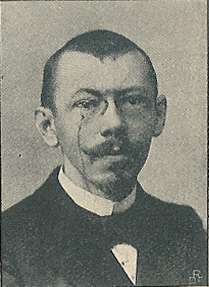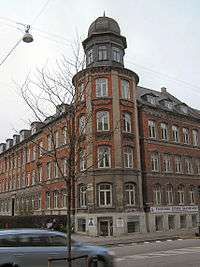Johannes Jørgensen
| Johannes Jørgensen | |
|---|---|
 | |
| Born |
6 November 1866 Svendborg |
| Died |
29 May 1956 Svendborg |
| Nationality | Danish |
| Alma mater | University of Copenhagen |
| Occupation | poet, writer, biographer |
| Notable work(s) | St. Francis of Assisi |
Jens Johannes Jørgensen (6 November 1866 in Svendborg – 29 May 1956) was a Danish writer, best known for his biographies of Catholic saints.
Early days
Johannes Jørgensen was born in 1866 in Svendborg, on the island of Funen. He was born into a seafaring family who were practicing Lutherans. As a student in Copenhagen, he embarked on a search for truth. He was briefly interested in theosophy, but he soon revolted against it. He was fascinated by the Russian nihilists and by Georg Brandes who boasted of dispelling "the darkness of Christianity." He led a life of pleasure and married, but his happiness did not last. New voices announcing spiritual values were then being heard in Denmark. Jørgensen read Joris-Karl Huysmans, Maurice Maeterlinck and others. He broke with Georg Brandes and his school, which would later cause his ruin.
Radical culture

When 16 years old, he traveled to Copenhagen to become a student in 1884 at Nørrebros Latin and Secondary school. A melancholy disposition and a sense of nature's diversity and beauty came to influence him throughout life. In Copenhagen he began to develop radical social views, which soon led him into a circle of cultural and radical artists.
The young poet
.jpg)
From his earliest years he showed a strong love of poetry through which he could express his dreams and observations. For rest of his life poetry remained as one of his prominent modes of expression.
But with his innate melancholy temperament, he found no permanent place in cultural radicalism and materialism, where Eros and connoisseur, summarized in pantheism's worship of nature was prevalent. Therefore, he began a quest for more spiritually motivated sources of inspiration together with like-minded people. It was the beginning of symbolism, where the magazine Tower as a spokesman sought new and untried ways and expressed itself in a metaphorical idiom, which is more similar to Johannes Jørgensen's sensitivity and temperament. As editor of the Tower, he developed a polemical rhetoric, which did tone easier for him in his fight for his ideas.
Symbolists quickly came across the prevailing literary circles, in particular, the brothers Georg and Edvard Brandes, who did not spare the young rebels.
Johannes Jørgensen then met a young Jew, silversmith Mogens Ballin, who had converted to Catholicism. He had not reached the spiritual depth he had sought. From his childhood home he had inherited an entrenched base of Christianity, and even at his most radical period this base never quite left him. It now returned in the form of mysticism. It took a long time with many internal battles before he found the port of spiritual comfort, though many internal and external factors constantly tore at him.
Conversion to the Catholic Church
In 1894 Jørgensen (together with Mogens Ballin) first visited the Basilica of San Francesco d'Assisi. It was the beginning of what would come to fill most of his future life as both man and writer – namely the love of the Holy St. Francis, Assisi's famous son who was born here and worked here until he died in 1226. The close friendship with Mogens Ballin and visiting the Basilica of St. Francis led to his conversion to Catholicism in 1896, a crucial turning point in his writing.
Saint biographies
In 1907 Jørgensen finished his biography of St. Francis, a book which would make him famous and an honorary citizen both in Assisi and later also in his native town of Svendborg. He had previously worked with the saint from Assisi. In 1902 he had translated Fioretti into Danish, and the following year he had published a book with the Pilgrim's depiction of the Franciscan sites.
The Franciscan'a spirituality came to dominate his thoughts. In 1915 settled in Assisi, only interrupted by the war years 1943–1945 when he traveled to Vadstena, Sweden to live and begin his great work on St. Birgitta. It was his third major biography of saints, following the book of St. Catherine of Siena (1915). His embracing of the Franciscan spirit led to a series of books based on the Umbrian world where spirit and nature always led to a higher unity.
Johannes Jørgensen's life had had an almost sentimental affinity to nature, seasons, flowers and life's affirmative diversity. This had developed into a pantheistic natural worship in his youth. But in the depiction of St. Francis's relationship with nature as God's true image, the two passion within him merged – nature and God. The deity who in his youth was the human relationship to nature now turned into an expression of God's truth.
Home to Denmark
After the war ended he returned to Assisi, but age was starting to weigh him down. In 1952 he moved back to Svendborg, where the city offered him free honorary residence in his childhood home of Lady Alley.
In 1913 he left his wife, Amalie f. Ewald and their 7 children after an increasingly problematic marriage. As a Catholic he could not remarry, but when Amalie died in 1935, he married (in 1937) Austrian-born Helen Klein.
He became an honorary citizen of Assisi 1922 and in Svendborg 1936 and dr. phil. hc ved Universitetet i Louvain 1927. Moreover, he was made Knight of the Dannebrog in 1920 and Commander of the 2nd grade 1926 . degree 1926.
Johannes Jørgensen died on 29 May 1956, almost 90 years old. He was buried at the city cemetery.
Pictorial representations
- Portrait painting by Johan Rohde, 1922 (Frederiksborg Castle) and Johannes Nielsen, 1937.
- Bust of Chresten Skikkild, 1926 in County Library in Svendborg.
- Drawings by Ragnvald Blix, 1904; Andrée Carof, 1915; Paolo Ghiglia, 1924; and Gerda Ploug Sarp.
- Woodcuts by Hans Olsen 1897 .
Analyzing his works
Johannes Jørgensen's writing is difficult to categorize.
His Catholicism made him interesting far outside the Catholic Church. In his travel books he can be compared to Fyn Hans Christian Andersen. His sublime sense of language has made him loved by many. While in Denmark he was a stranger, so his writing enjoyed much more attention at home than abroad, while Hans Christian Andersen is often translated from Danish.
Johannes Jørgensen's poetry is perhaps the most interesting part of his writing, and many read his poems in his homeland. Many look even today at his poetry for his beautiful styling and incomparable natural sense.
Kaj Munk
Following the murder of Kaj Munk on 4 January 1944 the Danish resistance newspaper De frie Danske brought condemning reactions from influential Scandinavians, including Jørgensen.[1]
Works
Among his works are:
- A stranger – novel, 1890
- Moods – poems, 1892
- Summer – novel, 1892
- Confession – poems, 1894
- Homesickness – novel, 1894
- Pilgrim book – travelogue, 1903
- St. Francis of Assisi – Biography, 1907
In the 18th edition of the Danish Folk High School Songbook there are three poems by John Jørgensen: Francis of Assisi Solsang "Almighty and dear God", "Now lit foliage in forests" and "Lay down your head, you blossom".
References
- ↑ "KAJ MUNK IN MEMORIAM". De frie Danske (in Danish). January 1944. p. 6. Retrieved 18 November 2014.
En stor Skjald, en Kristen, en stor Dramatiker er faldet for Morderhaand. Hans Minde vil leve paa Nordens Himmel som en blodig Bethlehemsstjerne
- Ove Klausen, Introduktion til Johannes Jørgensens forfatterskab, efterskift i Johannes Jørgensen, Tråden ovenfra. 1999.
- Stig Holsting og Oluf Schönbeck (red.), Fagerø. En antologi om Johannes Jørgensen og hans forfatterskab. 2006
- Teddy Petersen, Et menneske kommer derhen, hvor det vil. Biografi. 2006. ISBN 87-7887-391-6
- Henrik Denman, Johannes Jørgensen litteraturen. Bøger og artikler på dansk 1893-2007. 2008
- W. Glyn Jones, Han blev aldrig italiener. Johannes Jørgensens forfatterskab. 2008.
External links
| Wikimedia Commons has media related to Johannes Jørgensen. |
- http://www.abbaye-saint-benoit.ch/saints/catherine/revue/page19.htm#joergensen
- Works by Johannes Jørgensen at LibriVox (public domain audiobooks)
